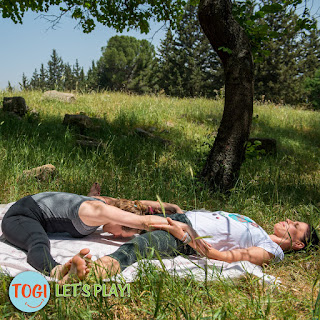Parents-children Acro-Yoga strengthens the parental connection, builds trust, builds confidence, improves self-esteem and generally speaking broadens the heart.
We recommend that you perform the exercises when another adult is around to stand on guard and prevent injuries. The exercises are performed slowly and while maintaining balance and attention of the child.
2 basic terms are: a. base – whoever lifts the other (in this case the parent) and b. flyer – the person being lifted up and balancing on the base (in this case, the child).
1. "Airplane" – parent as base, child as flyer.
The parent lie on the ground, lifting his legs with a mild spread of the hips, while the child "free-falls" on the parents legs and shifts all his body-weight to it. The parent then stretched its legs at a 90° angle, while the child spreads his hands to both sides while maintaining balance.
2. "Bat" – from the airplane position the child will move the weight of his upper body downwards with the parent supporting him by the back, while the parent legs are still in a 90° angle to the ground in order to maintain balance. Later on the parent can fold his legs if it's comfortable (in our case the height differences were too big).




3. "Bridge" – the parent is base, the child is a flyer.
The parent places his legs around the upper buttocks (where they meet the back) with a mild spread against the waist, while the child leans backwards when he is supported around the shoulder by the parent. The parent stretched his legs, and the child can hold the parent ankles, and with the help of another adult roll up towards the parent head and all the way to standing up.
4. "Bridge on the ground" - the parent stand with his legs spread above the child's head. The child holds his hands against the parent's ankles while his buttocks leans outside. While lifting the pelvis and placing the head on the ground the parent helps the child by holding his pelvis until a full bridge is formed.
5. "Head Stand", in stages. You start by sitting on your knees, ankles to buttocks, head on the ground supported by two hands tangled together. Place the upper part of your forehead against the mattress while leaning on your hands. Hold firmly against the ground/mattress/grass with your toes; this action allows the head to move and stabilize on the forehead so the neck stays long and stretched.
Push your shoulders upward and stretch your legs. Tiptoe towards the head until the toes are detached from the ground. The child can now rise to a head stand with the help of the parent who supports him by his pelvis.
This exercise can be practiced from the age of 5 you and onward, depends on the child abilities.




6. Sitting with a wide spread one against the other –
Legs are wide spread against the lower part of the child crus while the child legs are also spread. You hold hands with the child and lean backwards while the child leans forward with a straight back and deeper spread. You can later change leaning directions.
7. Back to Back –
Sitting and leaning against each other's back while your legs are straight. The child arms are raised up high, and the parent hold the child wrists while stretching forward.


Enjoy!
Sarit Miller- Facebook
our app (Android)- TOGI
All the responsibility is on the parent and/ or educator.
All the posts and materials belongs to togi let's play, and the writers ©











Happiness is always waiting next door.Body fitness is the most important things to take the body roles.I love to eat foodfoods; my best dish is banana bread recipe. Also, I love to do yoga
ReplyDelete